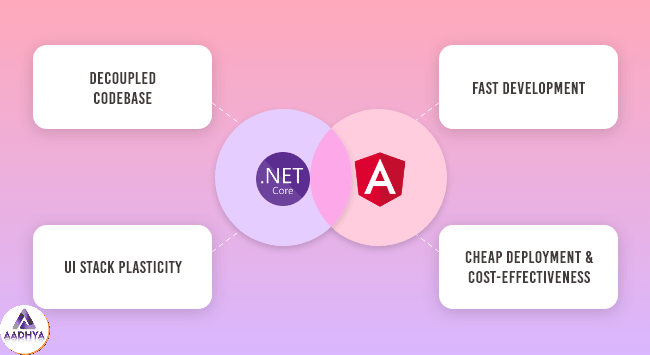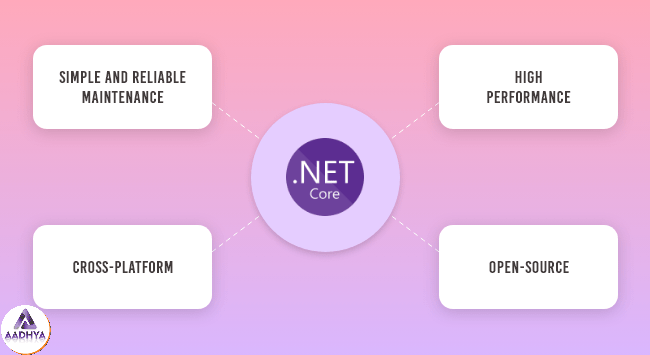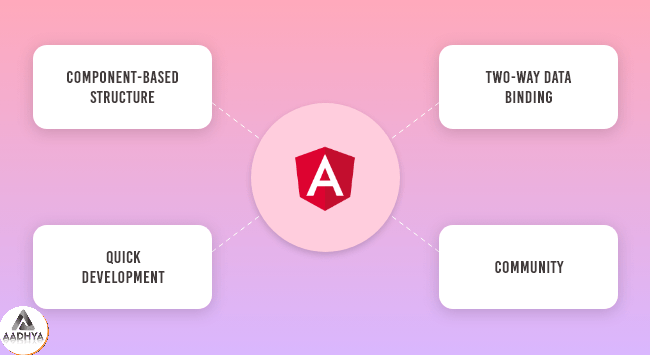Quick Summary:
Knowing the individual benefits of both these amazing technologies in their respective niche- Angular for frontend and ASP.NET Core for backend, is great, but don’t you wish to ace to the top with your business applications? This blog covers how can you make the most of both worlds by combining Angular with asp.net core.
Table of Contents
The Perks of Combining Angular With ASP.Net Core
Did you know that you might make the most out of selecting Angular With ASP.Net Core for the back
end of your online application? Read on to know the perks of combining the two!

1. Decoupled Codebase
While building Angular apps with asp.net core as your backend, your Angular code remains free and independent of the.NET code. In case you decide to combine it later, you may simply host it in a different repository. Now, because you’d hold the server side in hand, this feature would also be helpful if you choose to build up any mobile version in the future.
2. Fast Development
If you wish to create an effective Net Core web application quickly, the Angular with ASP.NET Core combo is undoubtedly a fantastic option. The development process can be sped up considerably because of the abundance of open-source and paid libraries available in both frameworks.
It should be acknowledged that TypeScript, a dynamically typed language akin to C#, is used in the
development of Angular. The TypeScript syntax is remarkably similar to the C# syntax. As a result of
this commonality, there are fewer errors and you can utilize the very same classes with minor adjustments
only.
3. Cheap Deployment and Cost-Effectiveness
Linux holds the title of the industry pioneer when it comes to enterprise servers and the cloud, despite
Windows having a significant market share on desktop computers.
As you might already be aware, .NET Core is open source, cross-platform, free, and works almost everywhere.
It is preferable to run .NET Core web applications on Linux platforms using open-source Angular.
In recent years, Linux Server deployment has surpassed Windows Server in terms of popularity due to its reduced
cost, simplicity of large-scale deployment, ease of customization, and availability of open-source software.
Ideally, Linux is a Unix-based operating system that offers a robust, dependable, and reliable system. Besides,
Linux is safe as well. It limits input from outside sources.
A perfect example of this is Visual Studio. Due to its ability to create self-contained applications, Visual
Studio 2017 lets programmers package a web application to operate on Linux. In comparison to the alternative,
this app is less expensive for businesses as it does not require the installation of the.NET SDK on a server.
4. UI Stack Plasticity
You have the option of combining native ASP.NET MVC UI with Angular too! Thanks to the versatility of the most
recent version of ASP.NET Razor and a few extensions from a variety of libraries. If you tend to favor back-end
development over front-end development, this drastically moves functionality from the client to the server. It
gives the opportunity to obtain the highest performance for the first-page load when combined with server-side
rendering.
Why .Net Core for Backend is a Savior?
Speaking of statistics, 77.2% of survey participants named .NET Core as their favorite non-web framework, as per
the Stack Overflow yearly Survey. Additionally, the .NET Core community has indeed received contributions from
3,700 businesses and more than 60,000 developers. Without a doubt, the future of .NET Core is quite bright. It
is even anticipated that .NET Core will be the focus of all future investments in .NET.
All in all, It might be said that Microsoft’s approach to application development has undergone a major revolution
with the introduction of the open-source cross-platform network, NET Core.
Note the benefits that businesses achieve by implementing .NET Core.

Simple and Reliable Maintenance
In contrast to numerous other languages,.NET Core uses a fantastic blend of C# and F#, which tends to make it much
more legible and simple. Designers can even arrange and improve the code in an effort for better performance. Less
code also indicates simpler upkeeping. Additionally, .NET programs have Microsoft’s pledged support, which helps
make them completely interoperable with all Microsoft products, secure, and have long-term reliability.
The modularity of .NET Core is one of its key advantages. It became significantly more lightweight and substantially
faster. All thanks to new memory allocation principles, strong community backing, and incredible Microsoft assistance.
It is easier for developers to produce effective, high-performing code by integrating the core libraries and enhancing
the tools. Because of the simpler upgrades and quicker development release, cycles, .NET Core is now one of the top
web frameworks available in the marketplace.
Open-source
.NET Core is an open-source framework in contrast to the .NET framework. Users can benefit greatly from open-source
software’s versatility. Each developer can participate in projects by proposing improvements, revisions, and suggestions
for how to repair problems. Because of the strong support from the open-source community, you may also alter the current
solution within minutes if it isn’t adequate/suitable for your requirements.
.NET Core can be installed on almost any operating system, according to your choices, in contrast to the .NET framework. NET framework
was designed to exclusively run on Windows. This is a significant benefit because it makes it simple to reuse the existing
environment and lower development expenses.
When not to use .NET core?
Even though .NET Core is regarded as an incredibly potent programming environment for the server-side creation of adaptable
and dynamic web programs, there is one minor drawback that needs to be noted.
Unable to be used with an old .NET library
Although.NET Core is a fantastic development environment for any OS, it is not as advanced as most other platforms. Despite
the.NET framework having a sizable class library, not all have been.NET Core optimized. Because of this,.NET Core’s primary
drawback is that it continues to be rather new and lacks a sufficient amount of modern libraries. This little shortcoming,
though, is readily solved. Credit goes to the .NET Core community which provides members with brilliant ongoing support.
The Advantages of .NET Core and The Way It Compliments Angular
Scalability
ASP.NET Core possesses scalability, which is crucial for expanding your applications and managing more traffic and demands while
ensuring optimal performance and stability. It also ensures your application can grow alongside your users without further issues.
Performance
ASP.NET Core’s performance is a strong suit for your Angular front apps, which leads to faster page loads and smoother interactions
for a better user experience.
Security
The framework ensures maximum security, focusing primarily on digital security and strong features for your Angular applications,
ranging from common web vulnerabilities. This helps ensure your users’ data and sensitive information are safe and secure.
Efficient Development
The Angular with .NET Core combination presents an exceptional development process with a unified C# language ecosystem; this helps
promote code reusability and improves collaboration within the team.
The Integration of Angular With .NET
Combining Angular with .NET requires integrating the frontend Angular application with the backend developed using the .NET
technologies. Here are the key integrations that you should follow:
API Communication
The Angular frontends communicate with the .NET backends using APIs. This involves defining the endpoints within the backend to
handle HTTP requests from Angular and send responses back to the front end.
Authentication and Authorization
Implementing the authentication and authorization mechanisms is important to ensure the security of your applications. The Angular
front-end uses techniques such as JWT (JSON Web Tokens) for authentication, and the .NET backend can handle authentication logic to
generate the tokens. The authorization rules are enforced on the backend to control resource access based on user roles and permissions.
Data Transfer
Data exchange between the Angular and the .NET backend occurs in JSON format over HTTP. The Angular HttpClient modules commonly make
HTTP requests to the backend APIs. In contrast, the backend uses libraries or inbuilt features to handle the incoming requests and
then send the appropriate responses.
Routing
The Angular routing system is used to navigate between different views or components within the application. Integration with the .NET
backend involves defining the routes on both the front and back end for handling the client-side and server-side routing, respectively.
Deployment and Hosting
After integrating the front-end and back-end is done and tested, your application must be deployed and hosted. The deployment involves
building the Angular application and publishing the .NET backend, then hosting them on a server or a cloud platform such as Azure, AWS,
or Heroku.
Error Handling
Ideal error-handling mechanisms must be implemented to manage errors during API calls or other operations. Angular can efficiently
handle client-side errors, whereas the .NET backend handles server-side errors effectively and returns ideal responses to the front
end.
Steps To Build Full-Stack Apps Combining Angular with .NET
Here are a few simple steps that you can follow to easily build your full-stack apps and combine Angular with the .NET frameworks.
Let us have a look at them:
Setting Up The Development Environment
Take a look at the steps given below to set up the development environment and ecosystem:
- Node.js and npm Installation:
Ensure that the Node.js and npm are properly installed within your system to manage the Angular dependencies.
- Angular CLI Installation:
Install the Angular CLI for easy and simple project creation, building, and testing.
- .NET Core 6 SDK Installation:
Install the .NET Core 6 SDK and the runtime for backend development.
Creating The Angular Frontend
Follow the steps given below and create your Angular front:
- Initializing Angular Project:
Start your app development process using the command prompt and running “ng new YourAppName.”
- Configuration:
Configure your API endpoints using the environment.ts or the environment-specific configuration files.
Creating The Backend With .NET
Now, follow the steps given below for creating the backend with the .NET framework:
- Framework Choice:
Choosing between the ASP.NET Core and ASP.NET model view frameworks for the backend.
- Project Creation:
Create your backend using the “dotnet new webapi -n projectname” within the command prompt.
- Database Setup:
Set up your database connections and implement the authentication for the backend.
Developing The Application
Refer to the steps below to develop your app by combining Angular with .NET.
- Angular Component Generation:
Use the Angular CLI to generate various application components.
- HTTP Requests Handling:
Leverage Angular’s HttpClient module to format HTTP requests to the backend API.
- Component Development:
Develop the components responsible for the data submission, manipulation, and retrieval.
Testing and Debugging
Refer to the steps given below to test and debug your application:
- Unit Testing Angular Components:
Compose your unit tests for the Angular components and the services using frameworks like Jasmine.
- Running Tests:
Run your tests with the “ng test” command in Angular CLI. Test your backend and employ the frameworks such as NUnit.
Deploying And Hosting
Follow the steps given below and deploy the host application:
- Angular Build:
Compile the application with the “ng build” Angular CLI Command.
- Publishing Backend:
To construct an executable package, publish the backend using the “dotnet publish” .NET CLI cmd.
- Hosting:
With knowledge of the process, host your app on a platform such as Microsoft Azure, AWS, or a private server.
Frontend With Angular Js Will Peak Your Success
The Angular framework was built specifically to make it easier to create user interfaces and get beyond the limitations of
other technologies in a single, integrated package. Today, Angular projects are backed by millions of people. Numerous
businesses offer training, distribute courses, and develop Angular
libraries. With unique updates and Angular core import capabilities, Angular is expected to leverage and amass more
attention in the coming years.
Here are 4 Major benefits of AngularJS that will help leverage your business and achieve success with your app built with
combining ASP.NET core with angular.

Component-Based Structure
The Angular framework’s component-based architecture is in charge of breaking the design down into its separate logical components.
Each component comprises pieces with linked functionality and is a self-contained piece of UI, screen, or route. This organization
offers more functionality and expedites the production and delivery of applications.
Two-Way Data Binding
The data synchronization that occurs between the Data Model and the View instantly and automatically is a great functionality
offered by Angular. Therefore, if the data store is updated, so is the user interface. Since no additional code is required for
ongoing View and Model synchronization, it substantially cuts down on production time.
A strong community is another factor that contributes to the market power and dependability of Angular projects. No matter what
state of development the program is in, a solid code base will always give it the support it needs. Every contemporary/modern IDE,
including IntelliJ WebStorm, Microsoft Visual Studio Code, etc., supports the Angular framework.
Quick Development
Because the Angular framework enables Angular core import and makes extensive use of pre-made components, creating Net Core web
apps takes much less time. Additionally, it comes pre-built with practically all popular architectural solutions.
When Angular May Not Be Right for You?
Businesses should consider multiple scenarios before deciding on Angular for front-end web application development because they
may call for a different front-end tech stack.
When Using Third-Party Components and Need High Flexibility
The necessity to modify the default behavior of Angular is expanding as third-party modules are utilized more frequently. It can be
difficult for an unskilled user to modify initial behavior or morph components into something else because these tasks are generally,
and not always simple.
ASP.Net Core With Angular: Supportive Templates
In order to assist in the creation of front-end-based apps with .NET Core as the backend, the ASP.NET team has created supportive
Angular and React templates. Furthermore, that template allows the hosting of both application kinds within a single instance.
Building and releasing applications together has proven to be advantageous. Angular templates offer commands that can be used in;
- Creating applications
- Updating apps with new code blocks
- Adding test specifications for units
- A test run
- Launch the app in development mode
- Create build files to deploy
Conclusion
Of all certainties, there isn’t a magic potion that can handle any business irrespective of
its requirements and business goals. However, the stack of Angular with ASP.NET Core succeeds in 99% of scenarios. With its modular
design, templating system, and asynchronous nature, Angular will enrich your app, while.NET Core will increase its efficiency in
terms of performance and security. Combining the two reaps tremendous benefits for businesses and their unique objectives.